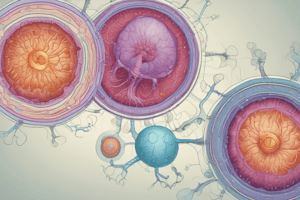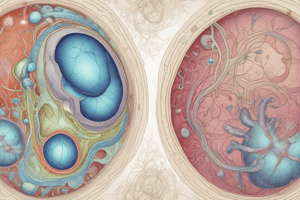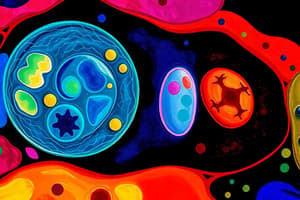Podcast
Questions and Answers
¿Cuál de las siguientes opciones describe mejor el enfoque principal de la biología?
¿Cuál de las siguientes opciones describe mejor el enfoque principal de la biología?
- La exploración de la historia geológica de la Tierra.
- El análisis de las estructuras, funciones, evolución y relaciones de los seres vivos con su entorno. (correct)
- La investigación de las leyes físicas que rigen el universo.
- El estudio de la composición química de la materia inerte.
El óvulo es una célula reproductora masculina producida por los testículos.
El óvulo es una célula reproductora masculina producida por los testículos.
False (B)
¿Qué estudia la embriología comparada?
¿Qué estudia la embriología comparada?
La embriología comparada se encarga de comparar los embriones de los seres vivos.
La embriología __________ proporciona la base química del desarrollo ortogénico.
La embriología __________ proporciona la base química del desarrollo ortogénico.
¿Qué siglo marcó el desarrollo de la embriología moderna, integrando disciplinas como la genética y la bioquímica?
¿Qué siglo marcó el desarrollo de la embriología moderna, integrando disciplinas como la genética y la bioquímica?
La teratología estudia exclusivamente las enfermedades infecciosas en embriones y fetos.
La teratología estudia exclusivamente las enfermedades infecciosas en embriones y fetos.
Menciona dos tipos de reproducción asexual.
Menciona dos tipos de reproducción asexual.
A un ser vivo también se le llama __________.
A un ser vivo también se le llama __________.
¿Cuál es el enfoque principal de la citología o biología celular?
¿Cuál es el enfoque principal de la citología o biología celular?
Los virus se clasifican dentro del reino de las moneras.
Los virus se clasifican dentro del reino de las moneras.
Nombra dos tipos de clasificaciones de los seres vivos.
Nombra dos tipos de clasificaciones de los seres vivos.
Las células están compuestas, entre otras cosas, por __________ orgánicas que son esenciales para su función.
Las células están compuestas, entre otras cosas, por __________ orgánicas que son esenciales para su función.
¿Cuál de los siguientes representa una característica fundamental de los seres vivos?
¿Cuál de los siguientes representa una característica fundamental de los seres vivos?
Según la teoría celular, todas las células provienen de materia no viva por generación espontánea.
Según la teoría celular, todas las células provienen de materia no viva por generación espontánea.
¿Dónde tienen lugar las funciones vitales del organismo según la teoría celular?
¿Dónde tienen lugar las funciones vitales del organismo según la teoría celular?
Cada célula contiene la información __________ necesaria para el control de su propio ciclo y desarrollo.
Cada célula contiene la información __________ necesaria para el control de su propio ciclo y desarrollo.
¿De qué están constituidos los ribosomas?
¿De qué están constituidos los ribosomas?
El aparato de Golgi está formado por sacos redondos llenos de agua.
El aparato de Golgi está formado por sacos redondos llenos de agua.
¿Qué tipo de ácido nucleico contienen los ribosomas?
¿Qué tipo de ácido nucleico contienen los ribosomas?
Las mitocondrias se encuentran entre los orgánulos más __________ de la célula.
Las mitocondrias se encuentran entre los orgánulos más __________ de la célula.
¿Cuál de las siguientes características es propia de las células procariotas?
¿Cuál de las siguientes características es propia de las células procariotas?
Las células eucariotas carecen de núcleo.
Las células eucariotas carecen de núcleo.
Nombra un ejemplo de organismo procariota.
Nombra un ejemplo de organismo procariota.
Animales, plantas, hongos y protistas son ejemplos de organismos __________.
Animales, plantas, hongos y protistas son ejemplos de organismos __________.
¿Qué ocurre durante la segmentación en el desarrollo embrionario?
¿Qué ocurre durante la segmentación en el desarrollo embrionario?
La blastulación es el proceso donde se forman los órganos del embrión.
La blastulación es el proceso donde se forman los órganos del embrión.
¿Qué proceso sucede durante la gastrulación?
¿Qué proceso sucede durante la gastrulación?
La organogénesis es la formación de __________ en el embrión a partir de las tres hojas embrionarias.
La organogénesis es la formación de __________ en el embrión a partir de las tres hojas embrionarias.
Empareja las siguientes ramas de la embriología con su descripción:
Empareja las siguientes ramas de la embriología con su descripción:
Según la teoría celular, ¿cuál de las siguientes afirmaciones es correcta?
Según la teoría celular, ¿cuál de las siguientes afirmaciones es correcta?
Flashcards
¿Qué es la Biología?
¿Qué es la Biología?
La ciencia de la vida, que estudia la estructura, función, evolución, desarrollo y relación de los seres vivos con su entorno.
¿Qué es el óvulo?
¿Qué es el óvulo?
Célula reproductora femenina, también llamada gameto femenino, producida por los ovarios.
Embriología comparada
Embriología comparada
Rama de la embriología que compara los embriones de diferentes seres vivos.
Embriología química
Embriología química
Signup and view all the flashcards
¿Qué estudia la teratología?
¿Qué estudia la teratología?
Signup and view all the flashcards
¿Tipos de reproducción asexual?
¿Tipos de reproducción asexual?
Signup and view all the flashcards
¿Otro nombre para 'ser vivo'?
¿Otro nombre para 'ser vivo'?
Signup and view all the flashcards
Citología (Biología celular)
Citología (Biología celular)
Signup and view all the flashcards
¿Cómo se clasifican los seres vivos?
¿Cómo se clasifican los seres vivos?
Signup and view all the flashcards
¿De qué están compuestas las células?
¿De qué están compuestas las células?
Signup and view all the flashcards
Características de los seres vivos
Características de los seres vivos
Signup and view all the flashcards
Teoría celular
Teoría celular
Signup and view all the flashcards
Gemación
Gemación
Signup and view all the flashcards
Mitosis
Mitosis
Signup and view all the flashcards
Cigoto
Cigoto
Signup and view all the flashcards
Meiosis
Meiosis
Signup and view all the flashcards
Ovogénesis
Ovogénesis
Signup and view all the flashcards
Espermatogénesis
Espermatogénesis
Signup and view all the flashcards
Embriología
Embriología
Signup and view all the flashcards
Embriología Química
Embriología Química
Signup and view all the flashcards
Fecundación
Fecundación
Signup and view all the flashcards
Partes de la célula
Partes de la célula
Signup and view all the flashcards
¿Qué son los ribosomas?
¿Qué son los ribosomas?
Signup and view all the flashcards
¿Cómo está formado el aparato de Golgi?
¿Cómo está formado el aparato de Golgi?
Signup and view all the flashcards
¿Qué contienen los ribosomas?
¿Qué contienen los ribosomas?
Signup and view all the flashcards
¿Dónde se encuentran las mitocondrias?
¿Dónde se encuentran las mitocondrias?
Signup and view all the flashcards
Segmentación (Desarrollo embrionario)
Segmentación (Desarrollo embrionario)
Signup and view all the flashcards
Blastulación
Blastulación
Signup and view all the flashcards
Gastrulación
Gastrulación
Signup and view all the flashcards
Organogénesis
Organogénesis
Signup and view all the flashcards
Study Notes
- Biology is defined as the science of life, studying the structure, function, evolution, development, and relationship of living beings with their environment.
- An ovule is the female reproductive cell, also called a female gamete, produced by the ovaries.
Branches of Embryology
- Comparative embryology compares the embryos of living beings.
- Chemical embryology provides the chemical basis for orthogenic development.
- Modern embryology developed in the early 21st century and complements various disciplines such as genetics, medicine, and biochemistry.
Teratology
- Teratology is the branch of biology that studies congenital malformations or anomalies in the development of living beings, especially in embryos and fetuses.
Types of Asexual Reproduction
-
Binary fission
-
Budding
-
Sporulation
-
A living being is also called an organism.
Cytology
- Cytology or cell biology is the branch of biology that studies cells, including their structure, functions, and importance in the complexity of living beings.
Classification of Living Beings
- Monera
- Fungi
- Archaebacteria
- Plants
- Protists
- Animals
Composition of Cells
- Organic molecule
- Replication + variety results in evolution
- Polymers
- Interaction between different molecules
- Limiting membrane
- Genetic code
- DNA as the basis of information
Characteristics of Living Beings
- Organization and complexity
- Growth
- Metabolism
- Reproduction
- Movement
- Adaptation
- Irritability
Cell Theory
- All living beings are formed by cells.
- All cells come from pre-existing cells.
- The vital functions of the organism occur within the cell or in its open system immediate environment, controlled by substances they secrete.
- Each cell contains all the hereditary information necessary to control its own cycle, development, and functioning of an organism of its species.
Concepts
- Budding occurs when new individuals are produced from buds or warts on the mother cell.
- Mitosis is a process that occurs in the nucleus of eukaryotic cells and immediately precedes cell division. It consists of the equal distribution of hereditary (DNA) material.
- Zygote is the cell resulting from the union of the male gamete and the female gamete during fertilization.
- Meiosis: This process takes place in the sex glands for the production of gametes.
- Oogenesis is the process of formation and maturation of the ovum, which takes place in the ovarian cortex.
- Spermatogenesis is the mechanism responsible for the production of spermatozoa.
- Embryology is responsible for developing and studying orthogenesis.
- Chemical embryology provides the chemical bases of orthogenic development.
- Fertilization consists of the fusion of male and female gametes to form zygotes consisting of the fusion of nuclei of the gametes.
Parts of a Cell
- Mitochondria
- Smooth Endoplasmic Reticulum (SER)
- Ribosomes
- Lysosomes
- Rough Endoplasmic Reticulum (RER)
- Golgi Complex
- Plastids
- Nucleolus
- Vacuoles
- Cell membrane
- Nucleus
Ribosomes
- Ribosomes are numerous organelles that are not surrounded by a membrane and are made up of two subunits.
Golgi Apparatus
- The Golgi apparatus is formed by flattened sacs surrounded by tubules and vesicles.
- Ribosomes contain ribosomal RNA and protein.
Mitochondria Location
- Mitochondria are found among the largest organelles of the cell.
Differences Between Prokaryotic and Eukaryotic Cells
- Prokaryotic cells:
- The nucleus is not defined.
- DNA is free in the cytoplasm.
- Is smaller.
- Few or no membrane bound organelles.
- Bacteria are an example.
- Eukaryotic cells:
- Has a true nucleus.
- DNA is within the nucleus.
- Is larger.
- More organelles with membrane. (like mitocondria)
- Animals, Plants, fungi and protists are examples.
Stages of Embryonic Development
- Segmentation: During this stage, the zygote undergoes a series of divisions that produce a large number of cells called blastomeres.
- Blastulation: Segmentation leads to a stage where the zygote reaches a large number of cells.
- Gastrulation: A set of processes that result in the formation of the fundamental layers of the embryo: ectoderm, mesoderm, and endoderm.
- Organogenesis: Consists of the formation of organs in the embryo from the three embryonic layers.
Studying That Suits You
Use AI to generate personalized quizzes and flashcards to suit your learning preferences.




